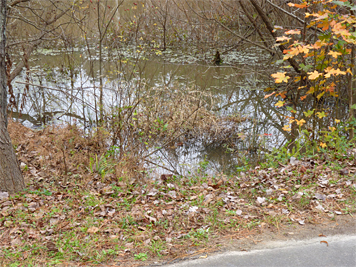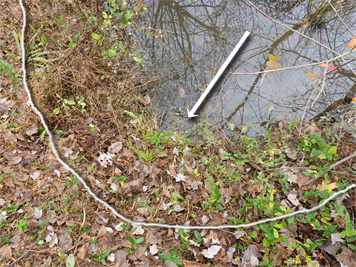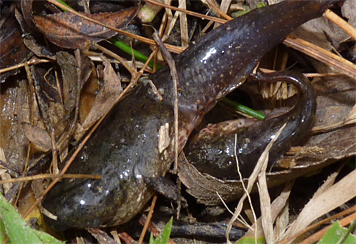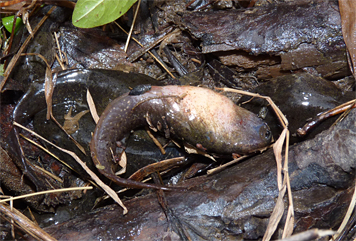During the last week in November I noticed a group of tadpoles individually surfacing and then quickly submerging in the murky water in the northwest corner of the Wetlands. There’s a pipe in that corner of the Wetlands which drains the higher ground above it. I’m not sure why this area is popular with tadpoles but the attraction must surely be related to the pipe; the same type of activity (a collection of tadpoles huddled together in this tiny corner of the Wetlands) occured last year at this time.

The first week of December brought with it several days of heavy rain. The Wetlands water level had risen a foot or more above normal but was quickly draining after the rain had stopped.

As I walked past the area in question I looked down to see if the tadpoles were still present following the deluge and noticed some the shriveled, brown leaves on the bank intermittently moving. I brushed aside one of the leaves. A large brown Bullfrog tadpole appeared. Turning back more leaves revealed more tadpoles. I tossed a few into the water. Apparently the tadpoles had become stranded when the water receded.

The rest of the day (and next day as well) more than two dozen of these stranded tadpoles were reunited with their kin by passing Museum Guests (both children and adults), school groups, and Museum Staff all pitching in to help out the tadpoles. It was quite enjoyable to see everyone get excited about joining in and helping with the effort.
Several questions emerged as a result of this little drama. Why hadn’t the tadpoles simply swum back into the water as the level fell? Should we have put them back in the water? After all, if they weren’t smart enough to know that the water level was dropping, intelligent enough to know that if they stayed where they were when the water level fell, that they’d be left high and dry, should we have saved them? If they lived for at least two days under the leaves, wouldn’t they survive longer, maybe wriggle down into the mud to stay moist (a dried up tadpole is a dead tadpole)? Does it harm the tadpoles to pick them up?

I don’t know the answer to all of those questions. Most of the tadpoles that overwinter (Bullfrog and Green Frog tadpoles may take a year or more to mature) tend to settle into the bottom under the mud, leaves and other debris during the cold months. Perhaps these tadpoles thought that they were doing just that, settling in. However, most of the tadpoles that I see in that corner of the Wetlands are very active, which is what attracted my attention to them in the first place.
Perhaps it would be best to let the tadpoles fend for themselves, there’s certainly no lack of tadpoles in the Wetlands, a few less wouldn’t make much of a difference. As I write this, another night of heavy rain has just ended and I’m sure that there will be more tadpoles lying under the leaves in that little corner of the Wetlands. I’ll probably leave them be.
As far as picking up tadpoles, I do know that amphibian skin is very sensitive and that whatever is on the hand of the person (soap, oils…) who picks up an amphibian may be transferred through the skin of that amphibian, possibly doing it harm. The tadpoles stranded alongside the Wetlands would almost certainly have died if not placed back into the water. If some were injured due to being picked up, I can’t say, but they surely would not have survived if left where they were.